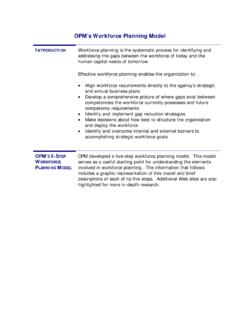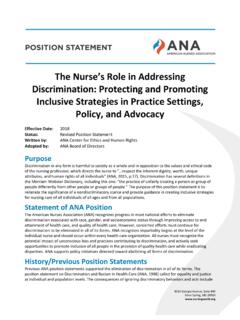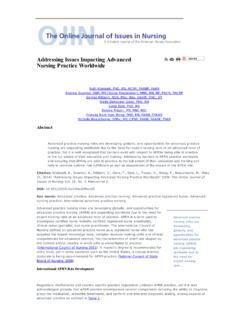Transcription of The Merit System Principles
1 The Merit System Principles Keys to Managing the Federal workforce Merit Systems Protection Board October 2020 Introduction The Merit System Principles : Keys to Managing the Federal workforce (October 2020) i Welcome to the Federal civil service! As an agency leader, you hold an important and visible position with great responsibility to yourself, your agency, the Federal Government, and the American people. Whether you are new to the Federal Government or simply moving into a new position, you will make important decisions about leading Federal employees every day. The Merit Systems Protection Board (MSPB) prepared this guide to help you understand the values and requirements of Federal Merit systems so you can successfully navigate those responsibilities.
2 Our goal is not to answer all of your questions, but rather to help you identify issues and recognize situations when you should seek advice from experts, such as your agency s human resources (HR) staff, on matters such as hiring, pay, recognition, managing performance, employee development, and retention. Although this booklet cannot prepare you for every challenge that you will face, it discusses keys to managing Federal employees fairly and effectively and identifies resources that can help you implement the Merit System Principles (MSPs) and avoid prohibited personnel practices (PPPs). Contents This guide provides: 1. Highlights from the history of the Federal civil service; 2. A set of questions and answers about the MSPs; 3. An overview of each MSP; and 4.
3 References for additional information. In Closing The MSPs allow agency leaders substantial discretion but they also mandate accountability for exercising that discretion wisely. By accepting a leadership position in the Federal civil service, you have committed to abide by the MSPs and to avoid and prevent PPPs. Thank you for taking the time to read this guide to the MSPs. Merit Systems Protection Board The mission of the Merit Systems Protection Board is to protect the Merit s ystem Principles and promote an effective Federal workforce free of prohibited personnel Brief History of the Federal Civil Service The Merit System Principles : Keys to Managing the Federal workforce (October 2020) 1 Federal employment originated in a spoils System in which hiring and firing of Federal Government workers was based on political loyalties.
4 Over time, dissatisfaction increased with the inefficiency of Federal employment based on political patronage, which valued connections over competence and produced staffing upheavals with each change in Administration. Ultimately, the assassination of President Garfield by a disgruntled job seeker persuaded Congress that change was necessary. The Pendleton Act of 1883 ended the practice of awarding Federal jobs on the basis of political affiliation or personal relationships and shifted Federal employment criteria to Merit for the vast majority of Federal positions. However, the Pendleton Act did not address terminations. Therefore, it did nothing to ensure that removals were purely due to poor performance or misconduct or to protect Federal employees from removal for disclosing wrongdoing within their agencies.
5 To address this need, in 1912, Congress enacted the Lloyd-LaFollette Act, which stated that removal actions must be for Merit -based reasons and not inappropriate causes, such as whistleblowing. By the late 1970s, concerns were increasing that fairness within the Merit System was being undermined and that personnel rules intended to preserve Merit had become so numerous and complex that they impeded agency ability to effectively manage employees and remove poor performers. Therefore, Congress pursued reforms that would both enhance managers ability to wisely manage while preserving the Principles of Merit and fairness and the legal and constitutional rights of Federal employees and applicants. The result was the Civil Service Reform Act (CSRA) of 1978 and related Reorganization Plans, which accomplished several goals.
6 To clarify expectations for the management of the Federal workforce , the CSRA established in law the MSPs and the PPPs, reinforcing or building on previous legislation. To balance System flexibility with System integrity, and to protect MSPs and prevent PPPs, the CSRA divided civil service responsibilities among several agencies, including MSPB (which initially included the Office of Special Counsel) and the Office of Personnel Management. To promote efficiency and effectiveness, CSRA provided that personnel authority would be exercised by individual agencies. Therefore, the primary responsibility for avoiding PPPs and attaining the ideals of the MSPs lies with employing agencies and their are the MSPs and PPPs? The Merit System Principles : Keys to Managing the Federal workforce (October 2020) 2 The Merit System Principles (MSPs) are nine basic standards that govern the management of the executive branch workforce and serve as the foundation of the Federal civil service.
7 The prohibited personnel practices (PPPs) are fourteen actions that are forbidden for employees who have the authority to make personnel decisions. Together, the MSPs and PPPs establish how the Federal workforce should be managed. What are the general themes of the MSPs and PPPs? Fairness treating employees fairly in all aspects of their employment. Protection refraining from misuse of authority and protecting employees from harm, such as reprisal for the exercise of a legally protected right. Stewardship managing employees in the short-term and long-term public interest. Who is responsible for upholding the MSPs and avoiding PPPs? All Federal employees are responsible. However, some employees have special responsibility: Agency leaders, as decision-makers and role models for the values distilled in the MSPs and PPPs; Supervisors, managers, and executives, as the officials who make decisions directly affecting the hiring, working conditions, utilization, and retention of Federal employees; and HR staff, as advisors on personnel authorities and how to exercise them.
8 What are the potential consequences of not supporting the MSPs? MSPB research shows that actual or perceived failure to abide by the MSPs can lead to Decreased individual and organizational performance; Increased Equal Employment Opportunity (EEO) complaints; and Increased intention to leave the agency. When Federal laws are violated, agencies may be subject to investigation, litigation, and enforcement, which can result in corrective action and payment of compensatory damages. Also, any employee responsible for the violation of an MSP or the commission of a PPP may be subject to loss of authority, discipline or removal, and fines. MSP1: Recruitment, Selection, and Advancement The Merit System Principles : Keys to Managing the Federal workforce (October 2020) 3 Recruitment should be from qualified individuals from appropriate sources in an endeavor to achieve a work force from all segments of society, and selection and advancement should be determined solely on the basis of relative ability, knowledge, and skills, after fair and open competition which assures that all receive equal opportunity.
9 Purpose of MSP 1 Focuses on attaining a well-qualified and representative workforce through open recruitment and fair, job-related assessment of applicants. Builds upon the Pendleton Act of 1883, which requires hiring and promotion based on qualifications such as knowledge, skills, and ability not political or personal connections. Affirms the importance of basing decisions on Merit and avoiding discrimination on the bases of race, color, religion, sex, and national origin (echoing Title VII of the Civil Rights Act of 1964 and related laws). Actions to Take Identify talent needs through job and workforce analyses. Actively seek diverse groups of prospective applicants through knowledgeable recruiters. Announce vacancies through a variety of media.
10 Use an appropriate mix of hiring authorities. Clearly describe the qualifications required to perform the job. Establish job-related and measurable selection criteria. Use assessments that are structured, valid and reliable. Identify and address barriers to open competition and equal opportunity. Actions to Avoid Automatically hiring to refill vacancies without conducting an analysis of needed competencies. Only posting vacancy announcements on USAJOBS. Relying exclusively or excessively on one or very few hiring authorities. Restricting competition through narrowly-focused recruitment or unreasonable application 2: Equity The Merit System Principles : Keys to Managing the Federal workforce (October 2020) 4 All employees and applicants for employment should receive fair and equitable treatment in all aspects of personnel management without regard to political affiliation, race, color, religion, national origin, sex, marital status, age, or handicapping condition, and with proper regard for their privacy and constitutional rights.













